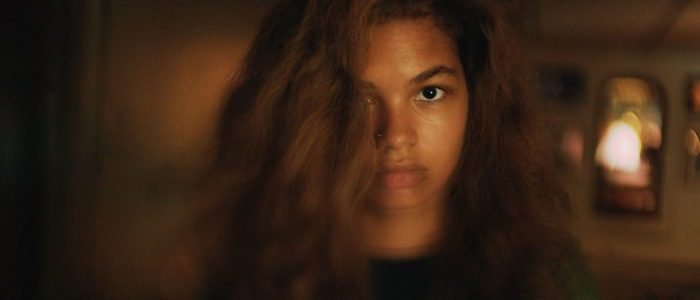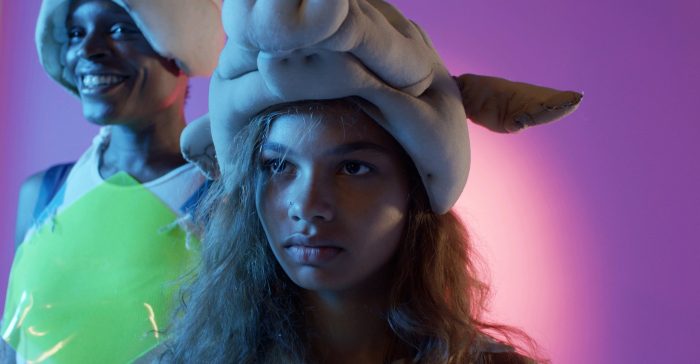'Madeline's Madeline,' One Of The Year's Best Films, Is A Brilliant Exploration Of Art, Artists, And Artistic Responsibility
(This article contains minor spoilers, but nothing that should diminish your enjoyment of the film.)
Madeline's Madeline is mind-boggling.
The phrase is seldom used as a compliment, though it takes experiencing the film first-hand to see why it fits. Josephine Decker's Thou Wast Mild and Lovely follow-up is decidedly Brechtian, opening by distancing itself from an audience who, by now, would've no doubt caught wind of its charms (the film was a hit at Sundance in January and Fantasia and it is in theaters today). "The emotions you are having are not your own," we're told up front, by a black nurse played by Okwui Okpokwasili, shot in angelic close up as the frame shimmers in and out of focus. "They are someone else's." We begin to experience physical space — a house, a room, the natural world — from a disorienting perspective. On the ground. Upon a table. Vantages we aren't used to. Okpokwasili clarifies, as we crawl towards an unseen woman and her ironing board, surrounded by what feels like a half-dressed set: "You are not the cat. You are inside the cat." Curious.
While a direct reminder that we're witnessing fiction, born through the convergence of a variety of creative impulses — writer-director Decker, cinematographer Ashley Connor, a tremendous lineup of sound artists, etc. — Okpokwasili's intro is as much a question as it is a statement of intent. I've mentioned Okpokwasili four times thus far, though I ought to clarify, the character she plays is at best a minor supporting role (we'll return to her shortly). Yet she, like so many of the film's seemingly minor facets, is vital to Madeline's story.
The plot is best described as that of troubled, biracial teenager Madeline (Helena Howard, in a herculean debut) as she deals with an unspecified mental illness, veering between her volatile home life, where things escalate at the drop of a hat, and her rehearsals with an improv/experimental theatre troupe whom she considers family. Its presentation however, renders any such explanation moot; there are discussions of what happens in the film below, though it's virtually spoiler-proof. How the film happens feels like magic.
Madeline is caught between two lives. Two frequencies. In effect, two mothers, both of them white. Miranda July plays her mother Regina, a single woman raising two kids; Molly Parker plays Evangeline, the enthusiastic director who bends Madeline's ear and helps her believe in her abilities. Though while both Regina and Evangeline are disparate destinations for a teen attempting to find herself, they each inadvertently attempt to craft a Madeline of their own liking. Regina, the ever concerned, ever on-edge, coddles her unpredictable daughter, but lashes out at every hint of change in behaviour — perhaps out of self-preservation, or perhaps protective instinct since Madeline refuses to take her meds. Evangeline, the more mellow mother, sits Madeline down and discusses her interior life in the broadest of strokes, nurturing the young actress as a means to an end through the creation of a character named Zia. To Evangeline, whose love is no doubt genuine, Madeline is a story to be found, and subsequently, told.

Madeline (like the actress who plays her) brims with unspeakable talent, able to map out complex emotional journeys in silence on the level of Daniel Kaluuya. Her stagecraft is simply stunning. Howard brings with her a gargantuan presence like few performers her age, but Madeline's creative spark is ultimately a conundrum; conventional wisdom might say she exists at the nexus of "genius" and "crazy," with the two states in symbiosis. We see the world through her eyes and ears in disorienting fashion; she absorbs information in bits and pieces, often in attempt to turn external stimulus into performance, modulating and filtering all she sees so as not to get overwhelmed.
Sounds, both within and surrounding a conversation, intrude and fade out at random. Minor details, like smirks and wrinkles, blur in and out of focus; the camera is in a constant state of exploration. In one moment, Madeline breathes in the whole picture of what's being said to her, and why. In the next, she grows concerned with her own inability to concentrate, as if concentrating on the act of concentrating to make up for it. Whether instructions on how a cat behaves or Evangeline unpacking (to poor effect, while creating Zia) the meaning of Madeline's dreams, the information Madeline retains sneaks its way in to subsequent rehearsals — inspiration, after all, isn't an exact science.
Madeline is a turtle, or rather inside it, as she's transported from an empty stage onto a beachfront, lugging around a shell as she learns more about her physicality. Madeline is a cat, or perhaps inside one, as she slinks across the floor, meowing to friends and strangers alike as she navigates her relationship to the people around her. Madeline is violent, or perhaps inside some violent version of herself, as she dreams, or fantasizes about, or maybe even remembers burning her mother with an iron. Is her art compartmentalizing these thoughts and experiences, or blurring the lines between them? Who can say. Whatever the case, they exist as an impulse, in some form, within her messy consciousness. As the cat, she learns to walk. As the turtle, she is born anew. As the violent Madeline, of the past or present or possible future, she projects some fundamental part of herself through this violent imagery.
Whether the true Madeline creates a more raucous image through art, or whether some phantom, disconnected Madeline gives way to her authentic self only when she performs, acting seems as close as she'll get to equilibrium in these formative years. Either way, this authentic self feels discombobulated. It's constructed through haphazard quests for identity that manifest as performance, whether as literal acting — Madeline uses the image of a pregnant Evangeline to conjure up a disturbing miscarriage scene alongside Okpokwasili's nurse, as a means to deal with her own hospitalization — or whether the kind of search for sexual identity that's expected of a girl her age. While still childishly giddy over her first kiss with a classmate, Madeline approaches Evangeline's black husband for tips on how to be promiscuous. Whatever the context, whether fun or therapeutic or some inseparable hybrid, her "performance" is always confrontational. It culminates in a devastating scene where she performs a true-to-life monologue from the perspective of her mother, with her mother as the audience, reducing them both to tears. For Madeline, art is a coping mechanism. For Evangeline however, it's an opportunity.

After numerous experiments and going back-and-forth on her own creative impulses, Evangeline places Madeline's personal monologue on a pedestal. This is her chance to make great art out of someone else's pain. This, finally, is Evangeline's Zia. She lays well-intentioned claim to the character while Madeline and Regina's wounds lie gaping in front of her. At last! A breakthrough! Though this is precisely where Okwui Okpokwasili's presence takes on paramount importance. Her character K.K. objects to this co-opting of trauma, resulting in the whole troupe questioning the ethics of Evangeline's approach, turning the film into a meta-text on its own creation.
Who is Evangeline, regardless of her proximity to blackness, to decide how this story ought to be told? Who is director Josephine Decker, a white woman, to step in and unpack the tale of a black biracial daughter and the walls she puts up between herself and her white mother and her black absentee father? Or for that matter, who is Decker to make Helena Howard, a biracial child, bare her soul so painfully on screen for white audiences to see? That Decker does so regardless of her trepidation feels both like a have/eat cake situation, as well as an inevitable outcome of asking the question in the first place. The "who" matters, in storytelling, as a means to questioning the "why" and "how," which Decker proceeds to do in gloriously mind-bending fashion.
The in-roads from this point on focus on neither the specifics of the mother-daughter relationships nor the racial dynamics between them; at least, not in the ways we're used to. The dynamics are ever-present, though the act of expanding upon them in words that neither Decker nor Madeline seem to have — albeit for different reasons — would feel specifically disingenuous to Madeline's Madeline. Instead of providing answers, it asks questions through its meta-text, allowing the actors to dig deep and create something unique and, dare I say, freeing.
Okwui Okpokwasili's casting isn't an accident ether. The Igbo-Nigerian American actress, dancer and performance artist is herself the mother of a biracial daughter, and she steps in for a mere handful of scenes where a performer of her caliber ordinarily might not. Her very presence in the rehearsal space recalls her self-choreographed performance in the documentary Bronx Gothic, which reaches into the depths of her life and childhood in order to craft a personal artistic statement, born from the constant pull-and-push between existing while black, and existing in a world of whiteness — for instance Okpokwasili's husband, a white man, directed the show, though she maintains that its power stems from her perspective. The haunting one-woman piece exorcises the demon that is numbness to black pain; no performance by the characters in Madeline's Madeline approaches nearly that level of physical intensity (Evangeline's trouple feels like a fun side project for everyone involved), that is, unless you count Madeline's plea to be heard as she falls at her mother's feet.
It's amidst the co-opting of Madeline's pain that Okpokwasili provides a hesitant voice of reason. Real art, as Okpokwasili and her character K.K. no doubt know, often comes from real suffering, but the role of the storyteller is one that must be investigated when stories like film and theatre act as collective social art forms, drawing from painful sources outside the self. And while Decker stepping aside in a film of her own making is a paradoxical no-go, she opts, instead, to take the power out of the hands of traditional cinematic narrative, thrusting her actors (and the actors they play) headfirst into their own abstract performance piece, born from collective spirit and in direct opposition to creating from selfishness, as a means to find new methods of expression.
The film, like its climax, is an artistic rebellion. It's constantly in search of new ways to tell stories that aren't constrained by an artistic lexicon cemented over a century — is it too soon to bring up Hannah Gadsby's Nanette? — a polished, binary visual language that often fails to capture the unspoken rough edges of race, gender and sexuality as building blocks of human experience.
Madeline's Madeline could not have existed in any form other than the formless, grounding its aesthetic anarchy in the chaotic worldview of a troubled young girl, as she tumbles between enormous expectations and adult realities that, despite their proximity or good-intentions, feel worlds removed. By fitting a conventional coming-of-age narrative into an experimental space, from scenes of rehearsal to centering a Black performance artist as creative conscience, the film cuts right to the heart of the expression itself, exploring the very mechanics by which we, as audiences and as artists, make sense of the world around us through creation. What's more, it goes the extra mile to ask how this enormous responsibility ought to be wielded.
***
Madeline's Madeline is in theaters today.
